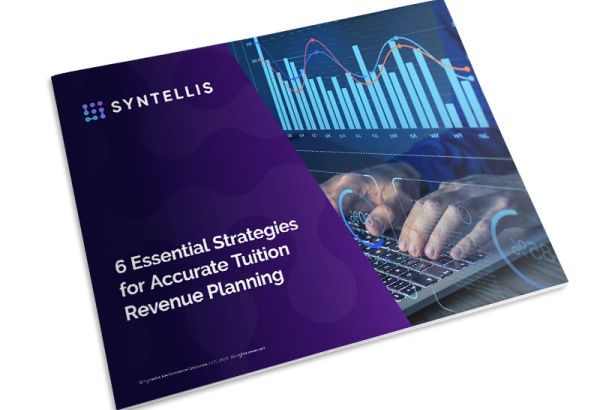College and university success can be measured in a range of ways, from graduation rates and student achievements to research breakthroughs and community partnerships.
To continue to deliver academic programming and support research and community initiatives, institutions must also measure financial success. Identifying and monitoring financial key performance indicators (KPIs) can enable colleges and universities to make informed strategic decisions, allocate resources more effectively, and maintain long-term viability.
There are hundreds, if not thousands, of metrics that college and university finance leaders can use to evaluate financial performance. We explore 10 of the top KPIs below.
1. Gross tuition revenue
Gross tuition revenue reflects the total income an institution generates through tuition costs. Tuition and fees as a share of revenue at public colleges has doubled since 1980, according to the latest State Higher Education Finance Report. As funding sources shift, monitoring gross tuition revenue can help universities set appropriate tuition rates from year to year.
2. Tuition discount rate
A school’s discount rate reflects total aid awarded to students as a percentage of gross tuition, including academic merit scholarships, grants, and other financial assistance. While tuition discounts are essential to attracting students from a range of financial backgrounds, institutions must balance those discounts with institutional needs. The higher the discount rate, the less net tuition revenue the institution collects.
3. Funding, grants, and donations
Colleges and universities typically receive a large portion of funding through government funds, grants, and alumni donations. According to the National Center for Education Statistics, 40% of revenues at public institutions come from government sources, and 46% of revenues at private nonprofit institutions come from investments, including earnings from endowments.
Tracking this aid in the annual planning process allows finance leaders to determine how much additional tuition and fee revenue is required to meet budget needs.
4. Student fees
As colleges and universities seek to fill gaps from diminishing funding from government sources and mandated restrictions on tuition increases, they should closely monitor student fees. These can include additional costs for specialty programs, room and board, transportation, and more. Together, fees and tuition make up a significant portion of many institutions’ revenue.
5. Net margin
Institutions must remain profitable to keep their doors open. With an understanding of net margin — the ratio of net income to expense — colleges and universities can better understand how much of each dollar of revenue collected translates to profit.
6. Instructional expense
Institutions should monitor the costs of full- and part-time faculty members, including wages and benefits. This KPI plays a vital role in recruitment and labor planning, allowing institutions to plan for existing roles — including long-term expenses for tenured faculty — and create new positions to meet student academic needs.
7. Staff cost as a percent of total cost
For many universities, a large portion of the budget is dedicated to salaries and benefits for staff members, including secretaries, registrars, counselors, and other roles that support faculty and administration. Monitoring staff costs as a percentage of total costs provides a better grasp of how much the institution spends on staff as a percentage of the total budget. With that insight, college leaders can offer more competitive salaries, attract talented employees, and enhance the institution’s reputation.
8. Administrative costs per student
College and university leaders should seek to understand how much the institution spends on administrative services to support day-to-day operations, on a per-student basis. This could include insurance policies, equipment and supplies, non-faculty salaries, and wraparound services in areas such as general health and mental health services.
9. Program and department budgets
Analyzing department or program budgets by semester or year can help predict future trends, ensure profitability, and allow for more accurate budgeting. Comparing initial budgets to actual spend can reveal where departments may be over- or underestimating so finance leaders can adjust processes for more precise future forecasts. This metric also provides insight into which programs and departments are profitable and which may need to be modified or reevaluated as part of the institution’s offerings.
10. Days cash on hand
This figure represents the number of days a college or university can fund expenses with its cash and investments that can be sold within one month, if no additional funds were coming in. This helps university leaders better manage cash flow and understand the institution’s ability to meet short-term financial obligations.
Understanding and tracking these KPIs can provide institutions with a solid foundation for long-term planning and budgeting, so they can serve students into the future. Syntellis’ Axiom Higher Education Suite offers integrated software for budgeting and forecasting, labor planning, and tuition planning to streamline the budgeting process and keep institution finances on track.
More strategies for measuring financial success

CFO Outlook for Higher Education

4 Reasons Advanced Solutions Exceed Excel for Tuition Revenue Planning


